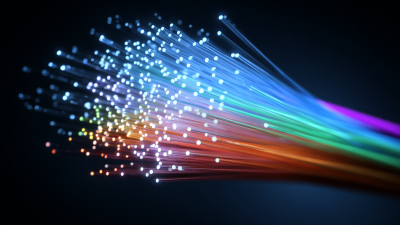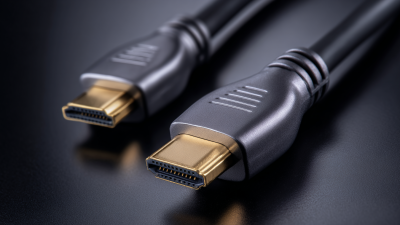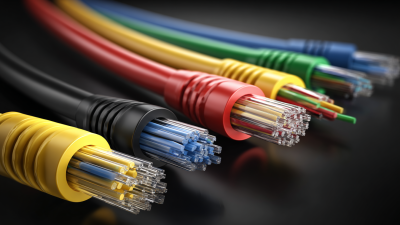Industries
Get direct access to our extensive portfolio of optical products and specialist technical expertise.
Get direct access to our extensive portfolio of optical products and specialist technical expertise.
In today’s digital landscape, the demand for efficient data transmission is driving the evolution of networking solutions, among which media converters play a pivotal role. According to a report by MarketsandMarkets, the global media converter market is expected to grow from USD 370 million in 2020 to USD 589 million by 2025, at a CAGR of 9.6%. This rapid growth underscores the increasing reliance on media converters to bridge connections between different media types, enhancing communication across varied network architectures.
 With options ranging from Ethernet to fiber optic conversions, understanding the diverse types of media converters and their specific applications is essential for businesses looking to optimize their network performance. As organizations continue to embrace digital transformation, knowing how to effectively implement these devices can significantly impact data integrity and transmission speed, making it crucial for professionals to grasp the intricacies of this technology.
With options ranging from Ethernet to fiber optic conversions, understanding the diverse types of media converters and their specific applications is essential for businesses looking to optimize their network performance. As organizations continue to embrace digital transformation, knowing how to effectively implement these devices can significantly impact data integrity and transmission speed, making it crucial for professionals to grasp the intricacies of this technology.
Media converters play a vital role in modern networking by enabling seamless communication between different types of media. At the core, these devices facilitate the conversion of data signals from one format to another, allowing for interoperability among diverse network infrastructures. The most common types of media converters include Ethernet to fiber converters, which are crucial for extending network distances and enhancing performance. By converting electrical signals into optical ones, these converters enable data transmission over long distances with minimal signal degradation, making them ideal for enterprise-level applications and expanding the reach of existing networks.
Another prevalent type is the fiber to fiber converter, which allows for different types of fiber optic cables—such as single-mode and multi-mode—to communicate. This flexibility is essential in optimizing network configurations and ensuring compatibility between various systems. Additionally, there are also wireless media converters that bridge wired networks with wireless systems, offering a versatile solution for mobile device connectivity. Applications vary from enhancing local area networks (LANs) to supporting video surveillance and other data-intensive tasks, showcasing the importance of understanding the specific functions and applications of each type of media converter in improving network efficiency and reliability.

Media converters play a vital role in modern network infrastructure by enabling the integration of different media types, such as fiber and copper. One of the key benefits of using media converters is their ability to extend network distances beyond the limitations of standard Ethernet connections. By converting electrical signals to optical signals, these devices allow for much longer transmission distances, making them essential for connecting remote locations or spanning large distances within a building.
**Tip:** When choosing a media converter, ensure that it supports the required data rates and distances for your network. Compatibility with existing equipment is crucial for seamless integration.
Additionally, media converters enhance network flexibility by facilitating the coexistence of various technologies. For example, businesses can gradually upgrade their networks from copper to fiber without the need for a complete overhaul. This not only saves costs but also allows for a smoother transition, ensuring minimal disruption to daily operations.
**Tip:** Always assess your current and future network needs to select the appropriate type of media converter that can grow with your infrastructure requirements.
Fiber to Ethernet converters play a crucial role in modern networking, especially as organizations continue to migrate from traditional copper infrastructure to fiber optics. These converters enable seamless communication between fiber optic networks and Ethernet-based devices, facilitating increased bandwidth and improved data transmission rates. According to a report from a leading market research firm, the global market for fiber optic converters is projected to grow at a CAGR of over 10% through the next five years, underscoring the increasing demand for reliable and efficient networking solutions.
The recent introduction of innovative signal converter solutions demonstrates the importance of bridging legacy systems with modern technology. For instance, the newly unveiled signal converter box is designed to support aircraft cabin systems, ensuring that older technology can still interact effectively with contemporary systems. This aligns with industry trends where the ability to integrate diverse systems is paramount, particularly in sectors like aviation and telecommunications. With a robust growth forecast, companies investing in fiber to Ethernet converters and similar technologies stand to gain significant advantages by enhancing connectivity and operational efficiency.
| Type of Media Converter | Description | Common Uses | Advantages |
|---|---|---|---|
| Fiber to Ethernet Converter | Converts fiber optic signals to Ethernet. | Connecting legacy Ethernet networks to fiber optic lines. | Increased bandwidth and greater distances. |
| Gigabit Media Converter | Supports Gigabit Ethernet over copper or fiber. | Upgrading network speed and connectivity. | High transfer rates and low latency. |
| PoE Media Converter | Provides Power over Ethernet alongside data. | Powering IP cameras, access points, and other devices. | Simplifies installation using a single cable. |
| Serial Media Converter | Converts serial signals to Ethernet or fiber. | Connecting legacy serial devices to modern networks. | Extends the life of older equipment. |
| Multimode to Singlemode Converter | Converts signals between multimode and singlemode fiber. | Interfacing between different fiber types. | Flexibility in network design and extensions. |
When selecting a media converter, it's essential to consider your specific needs to ensure optimal performance and compatibility. Media converters come in various types, each designed to handle different media formats and transmission distances. For instance, if you need to connect fiber optic cables to traditional copper networks, an Ethernet-to-fiber converter might be your best choice. These converters not only facilitate the integration of different media types but also enhance network speed and reliability.
Another important aspect to consider is the environment in which the media converter will operate. If your setup requires devices to function in harsh conditions—like extreme temperatures or exposure to dust—a ruggedized media converter would be more suitable. Additionally, understanding the data rate requirements and the distances involved in your network setup can help in selecting a converter that will meet your performance criteria. Therefore, carefully assessing your technical requirements and environmental factors will lead to choosing the right media converter for seamless connectivity.

Media converters play a crucial role in modern networking solutions by bridging different media types and enhancing connectivity. One of the primary use cases for media converters is in environments where legacy systems need to integrate with newer technologies. For instance, organizations may run older network infrastructure that utilizes Ethernet cabling but require connections to fiber optic networks for high-speed data transmission. By employing media converters, businesses can ensure a seamless transition between these differing technologies, allowing for gradual upgrades without the need for a complete overhaul.
Another significant application of media converters is in extending the reach of networks. Ethernet signals typically have a limited transmission distance, often capped at 100 meters. In scenarios where devices are located far apart, such as in sprawling campuses or industrial settings, media converters can be used to extend these distances. They effectively transform electrical signals into optical signals, enabling data to travel over fiber optic cables, which can span several kilometers. This capability ensures that organizations can maintain robust network performance and connectivity across expansive areas without sacrificing speed or reliability.



